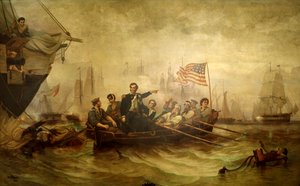Battle of Lake Erie
|
|
 Battle of Lake Erie by William H. Powell (1865): Perry transfers from the USS Lawrence to the USS Niagara | |||||||||||||||||||
| Battle of Lake Erie | |||||||||||||||||||
|---|---|---|---|---|---|---|---|---|---|---|---|---|---|---|---|---|---|---|---|
| Conflict | War of 1812 | ||||||||||||||||||
| Date | September 10, 1813 | ||||||||||||||||||
| Place | Lake Erie, near Put-in-Bay, Ohio | ||||||||||||||||||
| Result | Decisive American victory | ||||||||||||||||||
| |||||||||||||||||||
The Battle of Lake Erie, sometimes also referred to as the Battle of Put-in-Bay, was fought on September 10, 1813 in Lake Erie off the coast of Ohio. It was between nine ships of the United States Navy and six vessels of Great Britain. The decisive victory of the Americans over the British fleet ensured American control of the lake and the North-Western Territory during the War of 1812, opened supply lines, and improved American morale after a series of U.S. defeats in the Great Lakes theater. The successful U.S. invasion of Canada in the following month, culminating in the U.S. victory at the Battle of the Thames, is regarded by many historians as a critical factor in forcing the eventual stalemate in the war.
Background
The British had been blockading the port of Erie, Pennsylvania during the summer of 1813, but on August 1 they unexpectedly withdrew. The American ships in the harbor were finally able to leave, and throughout August, Oliver Hazard Perry prepared for the inevitable battle while keeping a close eye on the British ships at Detroit
The Battle
On September 10, British Commodore Robert Heriot Barclay, in his flagship HMS Detroit, met Captain Perry near Put-in-Bay, Ohio. Barclay's six ships outweighed and outgunned Perry's nine, including Perry's flagship, Lawrence. Lawrence faced an unfavourable wind and was destroyed in the course of the battle with four-fifths of its crew killed or wounded. However, Perry was able to row a half-mile through heavy gunfire and transfer command to Niagara, a ship equal in size and strength to Lawrence, but which had not yet been engaged in the battle. As HMS Detroit had suffered some damage, Niagara was able to capture it, along with the other five British ships.
Results
Each side suffered about 100 casualties. The vessels were anchored and hasty repairs were underway near West Sister Island when Perry composed his now famous message to William Henry Harrison. Scrawled in pencil on the back of an old envelope, Perry wrote:
- Dear General:
- We have met the enemy and they are ours. Two ships, two brigs, one schooner and one sloop.
- Yours with great respect and esteem,
- O.H. Perry
Wpdms_battleoflakeerie.jpg
Due to the outcome of the battle, Britain retreated from Detroit and lost control of Lake Erie for the remainder of the war.
After the war, the U.S. Navy intentionally sank both Lawrence and Niagara in Lake Erie; the battle damage they had suffered was too extensive to repair. In 1875, Lawrence was raised and moved to Philadelphia, where it was displayed at the 1876 Centennial Exposition. Later that year the ship burned when the pavilion that housed it caught fire. Although Niagara was raised and restored in 1913, it subsequently fell into disrepair. It was eventually disassembled and portions of it were used in a reconstructed Niagara, which is now on view in Erie, Pennsylvania.
The Perry Monument now stands atop Put-in-Bay, commemorating the men who fought in the battle.pl:Bitwa o Jezioro Erie
